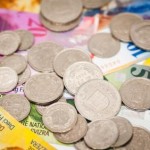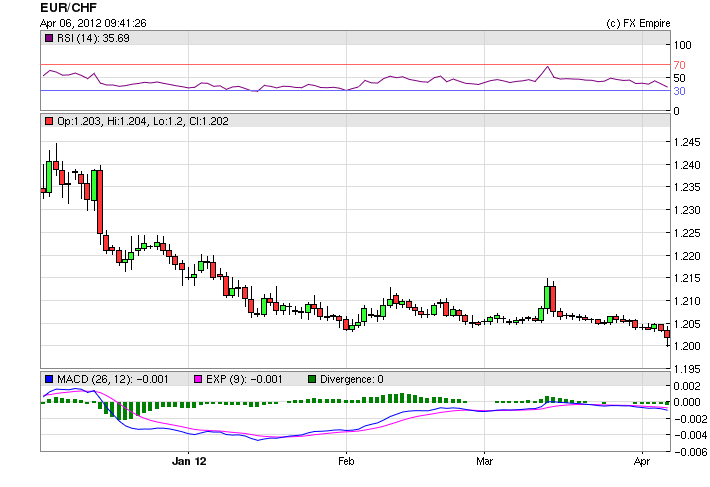By FXEmpire.com

EUR/CHF Monthly Fundamental Forecast April 2012
Outlook and Recommendation
The Swissie is trading at 1.2010 rumor are that the SNB intervened on Thursday April 5, 2012 to support the currency when it dipped to an asking price under the 1.20 range. The rumor has not been confirmed.
This month the pair has stayed fairly close to the 1.20-1.21 range as shown below.
The Swiss economy will stagnate this year; we expect weak external demand and investment activity to limit growth to less than 1/4 %. Real exports fell 3.4%m/m in January (in seasonally adjusted terms) as the manufacturing PMI declined to 47.3. The PMI has sat below theneutral-50 threshold since September. Like many of its wealthy European peers, the economy should register a moderate pace of recovery next year, advancing by around1 3/4 %. Deflation remains a considerable threat which could push the economy into recession; the consumer price index fell for a fourth consecutive month in January on a year over-year basis, with the pace of decline accelerating to0.8% y/y. If deflationary pressures intensify over the coming months, the SNB will likely opt to raise the currency floor, though with oil prices rising steadily year-to-date, the likelihood of this occurring has diminished. The next monetary policy announcement is on March 15th. Swiss fundamental and financial metrics remain very strong; the fiscal account is roughly balanced, public debt is declining and government bond yields are lower than their German and US counterparts. The central bank (SNB) continues to highlight the extreme CHF valuation, leaving open the risk that once leadership at the SNB is cemented the floor will shift
The Swiss National Bank (SNB) remains committed to upholding the exchange rate floor of CHF 1.20 per euro. The floor is seen as a credible monetary policy tool – effective in reducing foreign exchange volatility – and investor confidence in the SNB’s ability to maintain the floor is strong. Nevertheless, at the latest rate-setting meeting the monetary authorities noted that even with the minimum exchange rate the franc is still very strong, and downside risks to price stability have intensified in recent months (although, February saw the first monthly gain in the consumer price index since September on the back of higher oil prices). The rate of inflation this year is now expected to average -0.6% y/y. The central bank believes that the economy is starting to show signs of improvement and projects modest growth of 1% for 2012 following last year’s 1.9% advance. Although the pace of growth slowed throughout 2011, the economy avoided a contraction, unlike many of Switzerland’s European peers who saw output fall in the fourth quarter. The manufacturing PMI rose above the neutral 50-mark in March for the first time since last August. We have revised upward our growth forecast for this year, though we remain less optimistic than the central bank; we expect the drag from net trade to limit growth to just 1/2 %. Should the threat of deflation escalate – which we consider probable given the persistent uncertainty surrounding the outlook for the European currency union – the SNB will likely opt to raise the exchange rate floor.
The sovereign debt crisis in Europe has somewhat stabilized as the European Central Bank has eased bank funding and liquidity concerns while maintaining a loose monetary policy. Accordingly, a more stable credit market environment facilitated the sizable refinancing requirements of the first quarter of the year. The European ‘firewall’, though somewhat disappointing, has received agreement from major stakeholders and many sovereign debt spreads have eased off their highs. However, the risks are large, particularly as Spain appears to be struggling under strict austerity and disappointing growth. In addition, credit-default swap markets, which passed a major credibility test following the Greek debt restructuring, are still discounting Portugal’s inability to service its debt obligations.
Central Bank
ECB INTEREST RATE DECISION
Actual: 1%Cons.: 1%Previous: 1%
ECB Interest Rate Decision is announced by the European Central Bank. Usually if the ECB is hawkish about the inflationary outlook of the economy and rises the interest rates it is positive, or bullish, for the EUR. Likewise, if the ECB has a dovish view on the European economy and keeps the ongoing interest rate, or cuts the interest rate it is seen as negative, or bearish.
The Swiss National Bank(SNB) -None scheduled

Originally posted here



